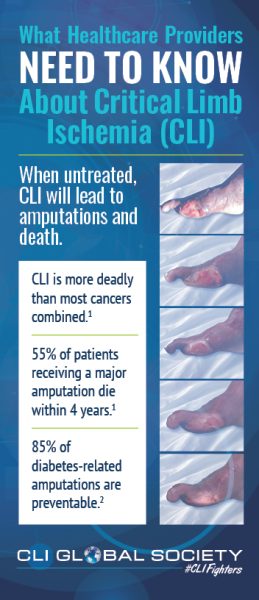Amputations Are Deadly: Life-Saving Options You Need To Know
The Critical Limb Ischemia (CLI) Global Society is urging individuals with poor leg and feet circulation to seek crucial information on new medical options that could potentially save their lives and limbs. This call to action comes in response to recent news reports regarding patients at risk of lower extremity amputations.
CLI is an advanced form of peripheral artery disease (PAD), a common circulatory disorder characterized by narrowed or blocked arteries that carry blood to the legs and feet. Risk factors for CLI include:
- Anyone age 50 or older
- Smoking/Nicotine
- Diabetes
- High blood pressure
- High cholesterol
- Heart disease
- Chronic kidney disease
CLI is a severely underdiagnosed and undertreated disease that poses a significant risk of amputation and mortality. It is estimated that between 1 and 3 million Americans suffer from CLI.1.
Left untreated, CLI can lead to non-healing wounds, gangrene, amputations, and eventually death. “The statistics are grim,” said Dr. Barry Katzen, President of the CLI Global Society. “We know that 60% of patients who undergo amputation due to PAD or CLI die within two years, surpassing the five-year mortality rate for patients with breast, colon, and prostate cancer”2.
Important statistics about CLI:
- Patients from racial and ethnic minority groups experience higher incidence and worse outcomes of PAD with 2 to 5 times higher amputation rates compared with white patients.3
- 85% of amputations could be avoided.4
- 51% of patients undergoing primary major amputation receive no previous revascularization*.2
- Up to 61% of patients die within 2 years of undergoing an amputation.2
- Up to 78% of patients die within 4 years of undergoing an amputation.2
- Patients who undergo an angiogram** have a 90% lower risk of major amputation than patients who do not.5
- Only one-third of patients with CLI are prescribed optimal medical therapy.6
- Compared to revascularization*, amputation doubles the risk of death over the next year.7
- Endovascular and surgical revascularization* doubles patient survival compared to amputation.7
- Major and minor amputation rates have increased by 50% from 2009 to 2015 with increasing rates more pronounced in younger adults with diabetes and PAD who are at highest risk for lower-extremity amputations.8
The CLI Global Society recommends the following measures to reduce amputation incidents in the CLI population9:
- Primary amputation should not be the first-line treatment for CLI unless there are mitigating circumstances (e.g., life-threatening sepsis, intractable infection, etc.).
- An interdisciplinary specialty care team should assess whether a CLI limb is salvageable.
- A digital subtraction angiogram** or equivalent vascular imaging that includes the ankle and foot should be performed to determine if limb salvage is possible before considering amputation.
Amputation should only be attempted if revascularization* has failed or is deemed futile.
To help bring awareness to this serious issue, the CLI Global Society is the proud clinical partner of the American Diabetes Association’s Amputation Prevention Alliance (APA). The APA has developed a set of principles to guide the advancement of legislation and policy changes that protect patients from unnecessary amputations. These principles aim to increase access to care, improve and incentivize quality care, and promote collaboration.
*Revascularization involves opening blocked or narrowed arteries to improve blood flow using minimally invasive and/or surgical procedures.
**Angiogram, also referred to as angiography, is an internal x-ray type of imaging that can detect blocked or narrowed arteries.
REFERENCES:
- Gerhard-Herman MD, Gornik HL, Barrett C, Barshes NR, Corriere MA, Drachman DE, Fleisher LA, Fowkes FG, Hamburg NM, Kinlay S, Lookstein R, Misra S, Mureebe L, Olin JW, Patel RA, Regensteiner JG, Schanzer A, Shishehbor MH, Stewart KJ, Treat-Jacobson D, Walsh ME. 2016 AHA/ACC Guideline on the management of patients with lower extremity peripheral artery disease: a report of the American College of Cardiology/American Heart Association Task Force on Clinical Practice Guidelines. J Am Coll Cardiol. 2017;69:e71–e126.
- Jihad A. Mustapha MD, Barry T. Katzen MD, Richard F. Neville MD, Robert A. Lookstein MD, Thomas Zeller MD, Larry E. Miller PhD, Michael R. Jaff DO. Determinants of Long-Term Outcomes and Costs in the Management of Critical Limb Ischemia: A Population-Based Cohort Study. J Am Heart Assoc. 2018;7:e009724. DOI: 10.1161/JAHA.118.009724.
- Newhall K, Spangler E, Dzebisashvili N, Goodman DC, Goodney P. Amputation rates for patients with diabetes and peripheral arterial disease: the effects of race and region. Ann Vasc Surg. 2016; 30:292–298.e1. doi 10.1016/j.avsg.2015.07.040
- Singh G, Chawla S. Amputation in Diabetic Patients. Med J Armed Forces India. 2006 Jan;62(1):36-9. doi: 10.1016/S0377-1237(06)80151-6. Epub 2011 Jul 21. PMID: 27407841; PMCID: PMC4923303.
- Henry AJ, Hevelone ND, Belkin M, Nguyen LL. Socioeconomic and hospital-related predictors of amputation for critical limb ischemia. J Vasc Surg. 2011;53(2):330-339.e1.
- Chung J, Timaran DA, Modrall JG, et al. Optimal medical therapy predicts amputation-free survival in chronic critical limb ischemia. J Vasc Surg. 2013;58:972-980.
- Mustapha JA, Katzen BT, Neville RF, et al. Disease burden and clinical outcomes following initial diagnosis of critical limb ischemia in the Medicare population. JACC Cardiovasc Interv. 2018;11:1011-1012.
- Criqui MH, Aboyans V. Epidemiology of peripheral artery disease. Circ Res 1015;116;1509-1526. doi: 10.1161/CIRCRESAHA.116.303849.
- Mustapha JA, Saab FA, Martinsen BJ, Pena CS, Zeller T, Driver VR, Neville RF, Lookstein R, van den Berg JS, Jaff MR, Michael P, Henao S, AlMahameed A, Katzen BT. Digital Subtraction Angiography Prior to an Amputation for Critical Limb Ischemia (CLI): An Expert Recommendation Statement from the CLI Global Society to Optimize Limb Salvage. J Endovasc Ther. 2020 May 29;1526602820928590. doi: 10.1177/1526602820928590. Online ahead of print.

